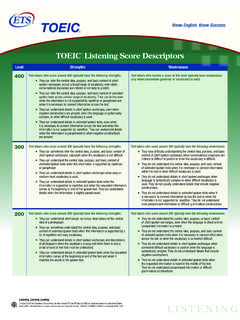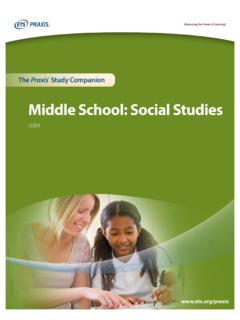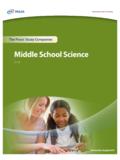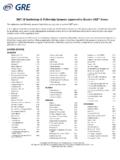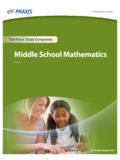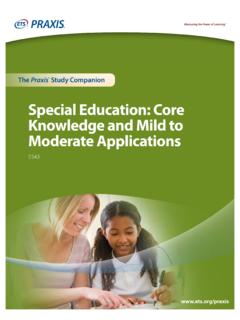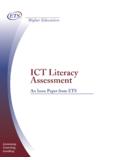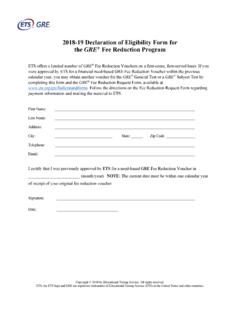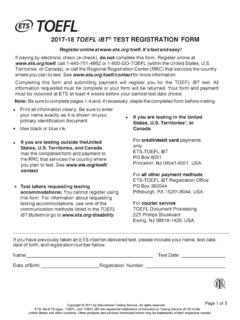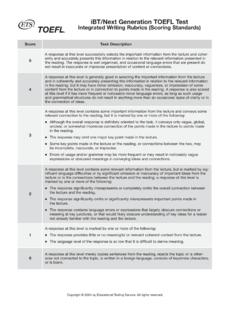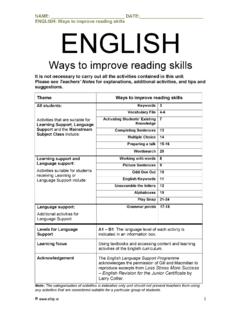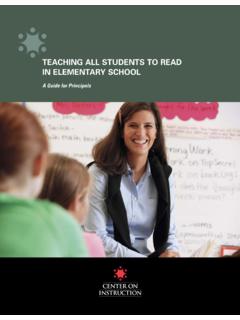Transcription of Understanding The Basic Reading Skills of U.S. Adults ...
1 Understanding the Basic Reading Skills of Adults : Reading Components in the PIAAC Literacy SurveyJohn Sabatini Educational Testing Service Princeton, December 2015 This report was written by: John Sabatini Educational Testing Service The views expressed in this report are those of the author and do not necessarily reflect the views of the officers and trustees of Educational Testing Service. View and download the report at: Copyright 2015 Educational Testing Service. All rights reserved. ETS and ETS logo are registered Trademarks of Educational Testing Service (ETS). MEASURING THE POWER OF LEARNING is a trademark of ETS. All other trademarks are the property of their respective owners. December 2015 ETS Center for Research on Human Capital and Education Research and Development Educational Testing Service Rosedale Road Princeton, NJ 08541-0001 TABLE OF CONTENTS Introduction.
2 1 Theoretical Background: Understanding the Reading Processes of Adults Using Reading Component Skills Tasks .. 4 Results .. 13 Review of Key Findings .. 31 Conclusions .. 39 Endnotes .. 40 Understanding THE Basic Reading Skills OF Adults : Reading Components in the PIAAC Literacy Survey1 INTRODUCTIONThe results of the Programme for the International Assessment of Adult Competencies(PIAAC) survey paint a troubling portrait of the literacy Skills of Adults in the The survey included a direct assessment of Skills and was conducted in 23countries with nationally representative samples of Adults ages 16 through were cognitive and workplace Skills needed for success in the 21st-centuryglobal economy. In a report entitled Time for the to Reskill? What the Survey ofAdult Skills Says,2 prepared by the OECD at the request of the Department ofEducation, it was found that the Skills of Adults in the United States have remainedrelatively unchanged in the decade since the previous report,3 while other countrieshave been showing improvements, especially among Adults with low Basic ability to read fluently and for Understanding to be able to learn from text isperhaps the most important foundational skill for adult citizens' health, well-being,and social and economic advancement.
3 It is a gateway to lifelong learning, education,and training. With the emergence of the Internet and social networking (which operateprimarily through the written word), Reading literacy provides control over animmeasurable, readily accessible library of the world's knowledge, as well as the abilityto communicate with friends, family, and employers. While the digital revolution hasincreased the prevalence of and, access to, visual/aural media, written text whetheron paper or screen continues to be an omnipresent currency of communication andcommerce, except for Adults who continue to struggle to who have trouble Reading , using mathematics, solving problems, and usingtechnology are at a disadvantage when competing for jobs in the The situation is perhaps most dire for those at the lowest level of readingliteracy Skills , because limited literacy skill reduces their access to print-based trainingand educational opportunities that could be used to enhance their social andworkforce Skills .
4 Low literacy Adults are not necessarily isolated, thanks to theever-present visual media and communications available. However, their potential islimited because they cannot use printed media to learn, grow their knowledge, andseek opportunities. Interpersonally, it is often painfully obvious to Adults when theycannot read well, as it also is to the casual observer. When confronted with text and atask, they can be observed puzzling and lingering for longer than proficient readers dowhen performing the same literacy surveys have consistently documented percentages of Adults who scoreat or below Level 1 on the Reading literacy proficiency scale,6 with internationalaverages at and for Below Level 1 and Level 1, respectively, in the mostrecent Before the PIAAC 2011 survey, however, essentially all that one couldinfer about the literacy Skills of Adults below Level 1 was that they could notconsistently perform accurately on the easiest literacy tasks on the survey.
5 One couldnot estimate what literacy tasks they could do successfully, if primary reason for introducing a battery of Reading component tasks to the PIAAC literacy assessment was the desire to have richer information from which to drawimplications for policy, as well as for learning and instruction, for Adults who score at orbelow Level 1 in literacy proficiency. What do we know about the Reading literacyprofiles of Adults with low literacy scores in the United States in comparison to othercountries? What are the underlying Reading Skills of Adults below Level 1 proficiency?Do they truly have no literacy Skills at all? For Adults at Level 1, is there evidence ofmastery of foundational component Skills ?Policy makers and educators can benefit from Understanding what kinds of Skills thatadults bring to learning programs, because the learning needs of those with very lowskill levels may differ from those with more intermediate levels of Skills ,8 as perhapsbest explained in the seminal work of Jean Chall distinguished learning toread that is, the mastery of decoding, word recognition, and Reading fluency fromreading to learn or to do that is, using text to build one's knowledge or accomplishspecific goals.
6 Adults at or below Level 1 have needs at both To build fluent,efficient foundational Reading Skills may require direct knowledge and skill instruction,as well as practice with applying Skills to build up fluency of application in literacycontexts at home or in the most elementary applied literacy tasks of the general, cognitive survey (forexample, locating a single piece of information in a paragraph of text), while easyrelative to the other tasks, are not the most Basic , foundational tasks that indicatereading literacy skill. Also, they are not aligned with evidence-based instructionalapproaches typically used when teaching beginning Component readingliteracy tasks, on the other hand, assess the foundational Skills that enable proseliteracy comprehension. Such tasks can probe knowledge of the alphabet, decoding,word recognition, word meaning knowledge, sentence comprehension, and basicpassage introduction of Reading component tasks in the 2011 PIAAC survey provided a richopportunity to better understand Adults with low literacy proficiency scores in theUnited States in comparison to similar populations in other countries.
7 Readingcomponents results help us to understand what Adults with scores at or below Level 1can and cannot do. Can they identify the meaning of high-frequency vocabulary wordsUNDERSTANDING THE Basic Reading Skills OF Adults : Reading Components in the PIAAC Literacy Survey2when they appear in print? Can they evaluate the meaning of single sentences? Canthey read for local meaning in simple passages? That is, what is the range and variationin foundational Skills among the lowest scoring Adults in a country? These are thequestions addressed in this sum, the Reading components tasks in PIAAC were designed to complement theapplied literacy tasks in order to provide a richer sense of what Adults scoring at orbelow Level 1 can and cannot do when engaging and processing Basic written words,sentences, and passages.
8 In the remainder of the report, we describe in more detail a)the Reading component measures, including the theoretical and empirical rationale foradopting this framework; b) the results in a select set of countries that participated inthe PIAAC survey; and c) implications of those findings for policy and THE Basic Reading Skills OF Adults : Reading Components in the PIAAC Literacy Survey3 THEORETICAL BACKGROUND: Understanding THEREADING PROCESSES OF Adults USING READINGCOMPONENT Skills TASKSUNDERSTANDING THE Basic Reading Skills OF Adults : Reading Components in the PIAAC Literacy Survey4 The PIAAC survey assessed the proficiency of Adults in three information-processingskills: literacy, numeracy, and problem solving in technology-rich environments. ForPIAAC, literacy is defined as " Understanding , evaluating, using and engaging withwritten texts to participate in society, to achieve one's goals, and to develop one'sknowledge and potential.
9 "13 In the main literacy assessment, texts could be digital(such as Web pages or emails) or print-based (such as newspapers, books, orpamphlets). Regardless of the format, texts could be continuous (such as passages),noncontinuous (such as tables or forms), mixed, or multiple (such as a blog post thatcontains an initial text and related responses or comments). These texts may naturallyappear in work-related, personal, social, community, or educational and trainingcontexts. Survey respondents were required to complete tasks that require applicationof cognitive strategies such as accessing, identifying, integrating, interpreting,evaluating, or reflecting on information in components, introduced for the first time in the 2011 PIAAC survey, are part ofthe literacy assessment framework, but targeted toward Adults near the bottom of theproficiency A detailed account of the PIAAC components assessmentframework can be found in Sabatini and Bruce,16 as well as in the Reading The rationale for component Skills rests on the premise that the"meaning construction" processes of Reading are built upon a foundation of knowledgeof how one's language is represented in one's writing system, that is.
10 Component Empirical studies in the Reading literature over the past several decades haveyielded a rich literature for Understanding component Reading processes in of an individual's level of print skill can be captured in tasks that can be usedto provide evidence of a reader's ability and efficiency in processing the elements ofthe written language letters/characters, words, sentences, and larger, continuous components are derived from a view of Reading literacy skill as a dimension oflanguage Language learning is typically thought of in four dimensions Reading , writing, speaking, and listening. For native speakers of languages,foundational speaking and listening Skills are acquired developmentally. Childrenacquire a productive/receptive vocabulary of words that we can refer to as theirlistening/speaking lexicon.
